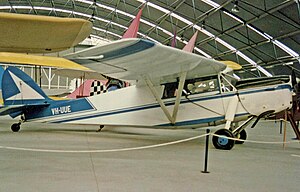avia.wikisort.org - Aeroplane
The de Havilland DH.85 Leopard Moth is a three-seat high-wing cabin monoplane designed and built by the de Havilland Aircraft Company in 1933.
| DH.85 Leopard Moth | |
|---|---|
 | |
| Leopard Moth exported to Australia in 1935, exhibited airworthy at the Drage Air World Museum at Wangaratta Airport Victoria in 1988 | |
| Role | Three-seat cabin monoplane |
| Manufacturer | de Havilland |
| First flight | 27 May 1933 |
| Introduction | 8 July 1933 |
| Primary users | United Kingdom private pilots Australian pilots |
| Produced | 1933-1936 |
| Number built | 133 |
Design and construction
It was a successor to the DH.80 Puss Moth and replaced it on the company's Stag Lane and later Hatfield production lines. It was similar in configuration to the earlier aircraft, but instead of a fuselage with tubular steel framework, a lighter all-plywood structure was used which allowed a substantial improvement in range, performance and capacity on the same type of engine. The pilot is seated centrally in front of two side-by-side passengers and the wings can be folded for hangarage.
Operational history
The prototype first flew on 27 May 1933 and in July won the King's Cup Race at an average speed of 139.5 mph (224.5 km/h), piloted by Geoffrey de Havilland. A total of 133 aircraft were built, including 71 for owners in the British Isles, and 10 for Australia. Other examples were exported to France, Germany, India, South Africa and Switzerland. Production of the Leopard Moth ended in 1936.
44 Leopard Moths were impressed into military service in Britain and others in Australia during World War II, mostly as communications aircraft. Only a few managed to survive six years of hard usage although a small number were still airworthy seventy years after the last was completed. Six remained operational in the U.K. in 2009.

Operators

Military operators
 Belgian Congo
Belgian Congo
- Aviation militaire de la Force publique First aircraft (C-1) entered service 9 October 1940.[1]
 Germany
Germany
- Luftwaffe (small numbers)[2]
 India
India
- Royal Indian Air Force
 Netherlands
Netherlands
- Dutch Army Aviation Group
 Portugal
Portugal
- Portuguese Air Force
 South Africa
South Africa
- South African Air Force
 Southern Rhodesia
Southern Rhodesia
- Southern Rhodesian Air Force operated one aircraft only.
 Spain
Spain
- Spanish Air Force
 Straits Settlements
Straits Settlements
- Malayan Volunteer Air Force
 United Kingdom
United Kingdom
- Royal Air Force impressed into service a number of former civil aircraft, using them as communications and liaison aircraft during the Second World War.
- Royal Navy impressed into service at least one former civil aircraft.
 Kingdom of Yugoslavia
Kingdom of Yugoslavia
- Royal Yugoslav Air Force operated one aircraft only.
Airline operators
 India
India
Specifications (DH.85)

Data from De Havilland Aircraft since 1909 [4]
General characteristics
- Crew: 1
- Capacity: 2 passengers
- Length: 24 ft 6 in (7.47 m)
- Wingspan: 37 ft 6 in (11.43 m)
- Height: 8 ft 9 in (2.67 m)
- Wing area: 206 sq ft (19.1 m2)
- Empty weight: 1,290 lb (585 kg)
- Max takeoff weight: 2,225 lb (1,009 kg)
- Powerplant: 1 × de Havilland Gipsy Major 4-cylinder air-cooled inverted in-line piston engine, 130 hp (97 kW)
- Propellers: 2-bladed fixed-pitch propeller
Performance
- Maximum speed: 137 mph (220 km/h, 119 kn)
- Cruise speed: 119 mph (192 km/h, 103 kn)
- Range: 715 mi (1,151 km, 621 nmi)
- Service ceiling: 21,500 ft (6,600 m)
- Rate of climb: 550 ft/min (2.8 m/s)
See also
Related development
Aircraft of comparable role, configuration, and era
- RWD-13
- Comte AC-12
References
- Luc Baudoux, Les Avions de la Force Publique du Congo Archived 2012-12-12 at the Wayback Machine, accessed October 2011
- Ketley, Barry, and Rolfe, Mark. Luftwaffe Fledglings 1935–1945: Luftwaffe Training Units and their Aircraft (Aldershot, GB: Hikoki Publications, 1996), p.11.
- Pran Nath Seth; Sushma Seth Bhat (2005). An Introduction To Travel And Tourism. Sterling Publishers Pvt. Ltd. p. 112. ISBN 978-81-207-2482-2.
- Jackson 1987, p.340.
Bibliography
- Comas, Matthieu (September–October 2020). "So British!: 1939–1940, les avions britanniques dans l'Armée de l'Air" [So British!: British Aircraft in the French Air Force 1939–1940]. Avions (in French) (236): 38–61. ISSN 1243-8650.
- A. J. Jackson (1987). De Havilland Aircraft since 1909 (Third ed.). London: Putnam. ISBN 0-85177-802-X.
- A. J. Jackson (1988). British Civil Aircraft 1919–1972: Volume II (1988 ed.). London: Putnam (Conway Maritime Press).
На других языках
[de] De Havilland DH.85 Leopard Moth
Die de Havilland DH.85 Leopard Moth war ein als Hochdecker konstruiertes dreisitziges Reiseflugzeug des britischen Herstellers de Havilland Aircraft Company aus dem Jahr 1933. Sie war die Nachfolgerin der DH.80 Puss Moth.- [en] De Havilland Leopard Moth
[fr] De Havilland DH.85 Leopard Moth
Le De Havilland DH.85 Leopard Moth était un avion de loisirs triplace monoplan à aile haute, conçu et produit par le constructeur britannique de Havilland Aircraft Company en 1933.[it] De Havilland DH.85 Leopard Moth
Il de Havilland DH.85 Leopard Moth fu un monomotore da trasporto ad ala alta, in grado di trasportare tre persone pilota compreso, prodotto dall'azienda britannica de Havilland negli anni trenta.Другой контент может иметь иную лицензию. Перед использованием материалов сайта WikiSort.org внимательно изучите правила лицензирования конкретных элементов наполнения сайта.
WikiSort.org - проект по пересортировке и дополнению контента Википедии